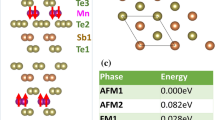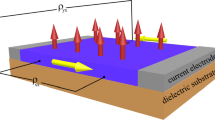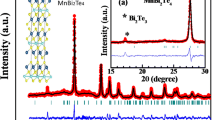Abstract
As a sister compound of MnBi2Te4, the high-quality MnSb2Te4 single crystals are grown via solid-state reaction where prolonged annealing and narrow temperature window play critical roles on account of its thermal metastability. Single-crystal X-ray diffraction (SCXRD) analysis on MnSb2Te4 illustrates a crystal model that is isostructural to MnBi2Te4, consisting of Te-Sb-Te-Mn-Te-Sb-Te septuple layers (SLs) stacking in an ABC sequence. However, MnSb2Te4 reveals a more pronounced cation intermixing in comparison with MnBi2Te4, comprising 28.9(7)% Sb antisite defects on the Mn (3a) site and 19.3(6)% Mn antisite defects on the Sb (6c) site, which may give rise to novel magnetic properties in emerging layered MnBi2Te4-family materials. Unlike the antiferromagnetic (AFM) nature in MnBi2Te4, MnSb2Te4 exhibits a glassy magnetic ground state below 24 K and can be easily tuned to a ferromagnetic state under a weak applied magnetic field. Its magnetic hysteresis, anisotropy, and relaxation process are investigated in detail via static and dynamic magnetization measurements. Moreover, anomalous Hall effect as a p-type conductor is demonstrated with transport measurements. This work grants MnSb2Te4 a possible access to the future exploration of exotic quantum physics by removing the odd/even layer number restraint in realizing quantum transport phenomena in intrinsic AFM MnBi2Te4-family materials, as a result of the crossover between its magnetism and potential topology arising from the Sb-Te layer.
摘要
作为MnBi2Te4的姊妹化合物, 高质量的MnSb2Te4单晶可以通过固态反应法合成; 而由于MnSb2Te4的热亚稳性, 长时间的退火和狭窄 的退火温区是合成的关键. 单晶X射线衍射分析结果说明MnSb2Te4具有与MnBi2Te4类似的晶体结构, 由七个原子层的Te-Sb-Te-Mn-Te-Sb-Te的层状结构单元沿面外方向以ABC顺序堆叠而成. 但是, 与MnBi2Te4相比, MnSb2Te4显示出更为严重的阳离子互占位, 表现为Mn (3a)位上的28.9(7)%Sb反位缺陷和Sb (6c)位上的19.3(6)%的Mn反位缺陷, 这种原子分布的变化能够为MnBi2Te4家族材料带来新的磁学特性. 与MnBi2Te4的反铁磁性质不同, MnSb2Te4在低于24 K的温度下展现出玻璃磁基态, 并且在弱的外加磁场下很容易被诱导至铁磁态. 通过静态和动态磁学测量, 我们详细研究了MnSb2Te4 的磁滞行为、磁各向异性和磁弛豫过程. 此外, 通过输运测量, 我们证明了合成的MnSb2Te4晶体是p型导体, 并且能够呈现出反常霍尔效应. MnSb2Te4的不同于MnBi2Te4的磁学特性与Sb-Te层产生的潜在拓扑特性相互作用, 有望突破反铁磁MnBi2Te4家族材料中实现量子输运现象的奇数或者偶数的层数限制,为新奇的量子物理学的探索带来新的可能.
Similar content being viewed by others
References
Hasan MZ, Kane CL. Colloquium: Topological insulators. Rev Mod Phys, 2010, 82: 3045–3067
Qi XL, Zhang SC. Topological insulators and superconductors. Rev Mod Phys, 2011, 83: 1057–1110
Haldane FDM. Nobel lecture: Topological quantum matter. Rev Mod Phys, 2017, 89: 040502
Fu L, Kane CL. Superconducting proximity effect and Majorana fermions at the surface of a topological insulator. Phys Rev Lett, 2008, 100: 096407
Essin AM, Moore JE, Vanderbilt D. Magnetoelectric polarizability and axion electrodynamics in crystalline insulators. Phys Rev Lett, 2009, 102: 146805
Tse WK, MacDonald AH. Giant magneto-optical Kerr effect and universal Faraday effect in thin-film topological insulators. Phys Rev Lett, 2010, 105: 057401
Chang CZ, Zhang J, Feng X, et al. Experimental observation of the quantum anomalous Hall effect in a magnetic topological insulator. Science, 2013, 340: 167–170
Chang CZ, Zhao W, Kim DY, et al. High-precision realization of robust quantum anomalous Hall state in a hard ferromagnetic topological insulator. Nat Mater, 2015, 14: 473–477
Katmis F, Lauter V, Nogueira FS, et al. A high-temperature ferromagnetic topological insulating phase by proximity coupling. Nature, 2016, 533: 513–516
Mogi M, Kawamura M, Yoshimi R, et al. A magnetic heterostructure of topological insulators as a candidate for an axion insulator. Nat Mater, 2017, 16: 516–521
Xiao D, Jiang J, Shin JH, et al. Realization of the axion insulator state in quantum anomalous Hall sandwich heterostructures. Phys Rev Lett, 2018, 120: 056801
Zhang H, Xu Y, Wang J, et al. Quantum spin Hall and quantum anomalous Hall states realized in junction quantum wells. Phys Rev Lett, 2014, 112: 216803
Mogi M, Kawamura M, Tsukazaki A, et al. Tailoring tricolor structure of magnetic topological insulator for robust axion insulator. Sci Adv, 2017, 3: eaao1669
Li J, Li Y, Du S, et al. Intrinsic magnetic topological insulators in van der Waals layered MnBi2Te4-family materials. Sci Adv, 2019, 5: eaaw5685
Zeugner A, Nietschke F, Wolter AUB, et al. Chemical aspects of the candidate antiferromagnetic topological insulator MnBi2Te4. Chem Mater, 2019, 31: 2795–2806
Chen KY, Wang BS, Yan JQ, et al. Suppression of the antiferromagnetic metallic state in the pressurized MnBi2Te4 single crystal. Phys Rev Mater, 2019, 3: 094201
Chen YJ, Xu LX, Li JH, et al. Topological electronic structure and its temperature evolution in antiferromagnetic topological insulator MnBi2Te4. Phys Rev X, 2019, 9: 041040
Cui J, Shi M, Wang H, et al. Transport properties of thin flakes of the antiferromagnetic topological insulator MnBi2Te4. Phys Rev B, 2019, 99: 155125
Li J, Wang C, Zhang Z, et al. Magnetically controllable topological quantum phase transitions in the antiferromagnetic topological insulator MnBi2Te4. Phys Rev B, 2019, 100: 121103
Li Y, Jiang Z, Li J, et al. Magnetic anisotropy of the two-dimensional ferromagnetic insulator MnBi2Te4. Phys Rev B, 2019, 100: 134438
Otrokov MM, Klimovskikh II, Bentmann H, et al. Prediction and observation of an antiferromagnetic topological insulator. Nature, 2019, 576: 416–422
Otrokov MM, Rusinov IP, Blanco-Rey M, et al. Unique thickness-dependent properties of the van der Waals interlayer antiferromagnet MnBi2Te4 Films. Phys Rev Lett, 2019, 122: 107202
Peng Y, Xu Y. Proximity-induced Majorana hinge modes in anti-ferromagnetic topological insulators. Phys Rev B, 2019, 99: 195431
Rani P, Saxena A, Sultana R, et al. Crystal growth and basic transport and magnetic properties of MnBi2Te4. J Supercond Nov Magn, 2019, 32: 3705–3709
Rienks EDL, Wimmer S, Sánchez-Barriga J, et al. Large magnetic gap at the Dirac point in Bi2Te3/MnBi2Te4 heterostructures. Nature, 2019, 576: 423–428
Vidal RC, Bentmann H, Peixoto TRF, et al. Surface states and Rashba-type spin polarization in antiferromagnetic MnBi2Te4 (0001). Phys Rev B, 2019, 100: 121104
Yan JQ, Zhang Q, Heitmann T, et al. Crystal growth and magnetic structure of MnBi2Te4. Phys Rev Mater, 2019, 3: 064202
Zhang D, Shi M, Zhu T, et al. Topological axion states in the magnetic insulator MnBi2Te4 with the quantized magnetoelectric effect. Phys Rev Lett, 2019, 122: 206401
Li H, Liu S, Liu C, et al. Antiferromagnetic topological insulator MnBi2Te4: Synthesis and magnetic properties. Phys Chem Chem Phys, 2020, 22: 556–563
Zhang S, Wang R, Wang X, et al. Experimental observation of the gate-controlled reversal of the anomalous Hall effect in the intrinsic magnetic topological insulator MnBi2Te4 device. Nano Lett, 2020, 20: 709–714
Liu C, Wang Y, Li H, et al. Robust axion insulator and Chern insulator phases in a two-dimensional antiferromagnetic topological insulator. Nat Mater, 2020, 19: 522–527
Deng Y, Yu Y, Shi MZ, et al. Quantum anomalous Hall effect in intrinsic magnetic topological insulator MnBi2Te4. Science, 2020, 367: 895–900
Chen L, Wang D, Shi C, et al. Electronic structure and magnetism of MnSb2Te4. J Mater Sci, 2020, 55: 14292–14300
Yan JQ, Okamoto S, McGuire MA, et al. Evolution of structural, magnetic, and transport properties in MnBi2−xSbxTe4. Phys Rev B, 2019, 100: 104409
Murakami T, Nambu Y, Koretsune T, et al. Realization of interlayer ferromagnetic interaction in MnSb2Te4 toward the magnetic Weyl semimetal state. Phys Rev B, 2019, 100: 195103
Dolomanov OV, Bourhis LJ, Gildea RJ, et al. OLEX2: A complete structure solution, refinement and analysis program. J Appl Crystlogr, 2009, 42: 339–341
Sheldrick GM. SHELXT-Integrated space-group and crystal-structure determination. Acta Crystlogr A Found Adv, 2015, 71: 3–8
Sheldrick GM. Crystal structure refinement with SHELXL. Acta Crystlogr C Struct Chem, 2015, 71: 3–8
Bałanda M. Ac susceptibility studies of phase transitions and magnetic relaxation: Conventional, molecular and low-dimensional magnets. Acta Phys Pol A, 2013, 124: 964–976
Topping CV, Blundell SJ. A.C. susceptibility as a probe of low-frequency magnetic dynamics. J Phys-Condens Matter, 2019, 31: 013001
Binder K, Young AP. Spin glasses: Experimental facts, theoretical concepts, and open questions. Rev Mod Phys, 1986, 58: 801–976
Wu J, Liu F, Liu C, et al. Toward 2D magnets in the (MnBi2Te4) (Bi2Te3)n bulk crystal. Adv Mater, 2020, 32: 2001815
Zheng L, Cheng X, Cao D, et al. Direct growth of Sb2Te3 on graphene by atomic layer deposition. RSC Adv, 2015, 5: 40007–40011
Schaumann J, Loor M, Ünal D, et al. Improving the zT value of thermoelectrics by nanostructuring: Tuning the nanoparticle morphology of Sb2Te3 by using ionic liquids. Dalton Trans, 2017, 46: 656–668
Iwanowski RJ, Heinonen MH, Janik E. X-ray photoelectron spectra of zinc-blende MnTe. Chem Phys Lett, 2004, 387: 110–115
Iwanowski RJ, Heinonen MH, Janik E. Sputter cleaning and annealing of zinc-blende MnTe surface—XPS study. Appl Surf Sci, 2005, 249: 222–230
Kim W, Park IJ, Kim HJ, et al. Room-temperature ferromagnetic property in MnTe semiconductor thin film grown by molecular beam epitaxy. IEEE Trans Magn, 2009, 45: 2424–2427
Iwanowski RJ, Heinonen MH, Witkowska B. X-ray photoelectron study of NiAs-type MnTe. J Alloys Compd, 2010, 491: 13–17
Kuropatwa BA, Kleinke H. Thermoelectric properties of stoichiometric compounds in the (SnTe)x(Bi2Te3)y system. Z Anorg Allg Chem, 2012, 638: 2640–2647
Gomis O, Vilaplana R, Manjón FJ, et al. Lattice dynamics of Sb2Te3 at high pressures. Phys Rev B, 2011, 84: 174305
Das D, Malik K, Deb AK, et al. Defect induced structural and thermoelectric properties of Sb2Te3 alloy. J Appl Phys, 2015, 118: 045102
Mydosh JA. Spin Glasses: An Experimental Introduction. London: Taylor & Francis, 1993
Sun X, Song Y, Deng J, et al. New layered chromium chalcogenides CsLiCrSe2, RbLiCrS2 and CsLiCrS2: Structures and properties. Dalton Trans, 2019, 48: 17572–17578
Liu Y, Wang LL, Zheng Q, et al. Site mixing for engineering magnetic topological insulators. Phys Rev X, 2021, 11: 021033
Shi G, Zhang M, Yan D, et al. Anomalous Hall effect in layered ferrimagnet MnSb2Te4. Chin Phys Lett, 2020, 37: 047301
Shang M, Chen Y, Tian G, et al. Re-entrant spin glass and stepped magnetization in mixed-valence SrFe3(PO4)3. Phys B-Condensed Matter, 2013, 409: 42–46
Vlášková K, Colman RH, Proschek P, et al. Evidence for spin-glass ground state in fluorite-defect Er2Zr2O7 single crystals. Phys Rev B, 2019, 100: 214405
Liu C, Tao X, Kan X, et al. Spin-glass behavior in Co-based anti-perovskite compound SnNCo3. Appl Phys Lett, 2020, 116: 052401
Acknowledgements
The work was supported by the Basic Science Center Project of the National Natural Science Foundation of China (51788104), the Ministry of Science and Technology of China (2018YFA0307100), and the National Natural Science Foundation of China (51991340 and 21975140). This work at Rutgers was supported by the Beckman Young Investigator award.
Author information
Authors and Affiliations
Contributions
Author contributions Li H and Wu Y conceived the idea and designed the experiments. Li H performed the synthesis, characterization and magnetic measurement. Li Y and Zhang J carried out the transport measurements. Lian Y, Chen L and Xie W contributes to the SCXRD measurements and structure refinement. The paper was written by Li H and Wu Y. Fan S supervised the study. All authors helped in the revision of the paper and contributed to the general discussion.
Corresponding author
Ethics declarations
Conflict of interest The authors declare that they have no conflict of interest.
Additional information
Supplementary information Supporting data are available in the online version of the paper.
Hao Li received her BSc from the University of Science and Technology of China in 2016. She is now a doctoral candidate of materials science and engineering at Tsinghua University. Her research includes exploratory synthesis and physical properties of low-dimensional topological materials.
Yang Wu received his BSc from Tsinghua University in 2002 and PhD from Arizona State University in 2011. He is an associate professor at the Department of Mechanical Engineering and Tsinghua-Foxconn Nanotechnology Research Center of Tsinghua University. His research interests focus on the synthesis of energy storage materials and topological quantum materials.
Supplementary Information
Rights and permissions
About this article
Cite this article
Li, H., Li, Y., Lian, Y. et al. Glassy magnetic ground state in layered compound MnSb2Te4. Sci. China Mater. 65, 477–485 (2022). https://doi.org/10.1007/s40843-021-1738-9
Received:
Accepted:
Published:
Issue Date:
DOI: https://doi.org/10.1007/s40843-021-1738-9




